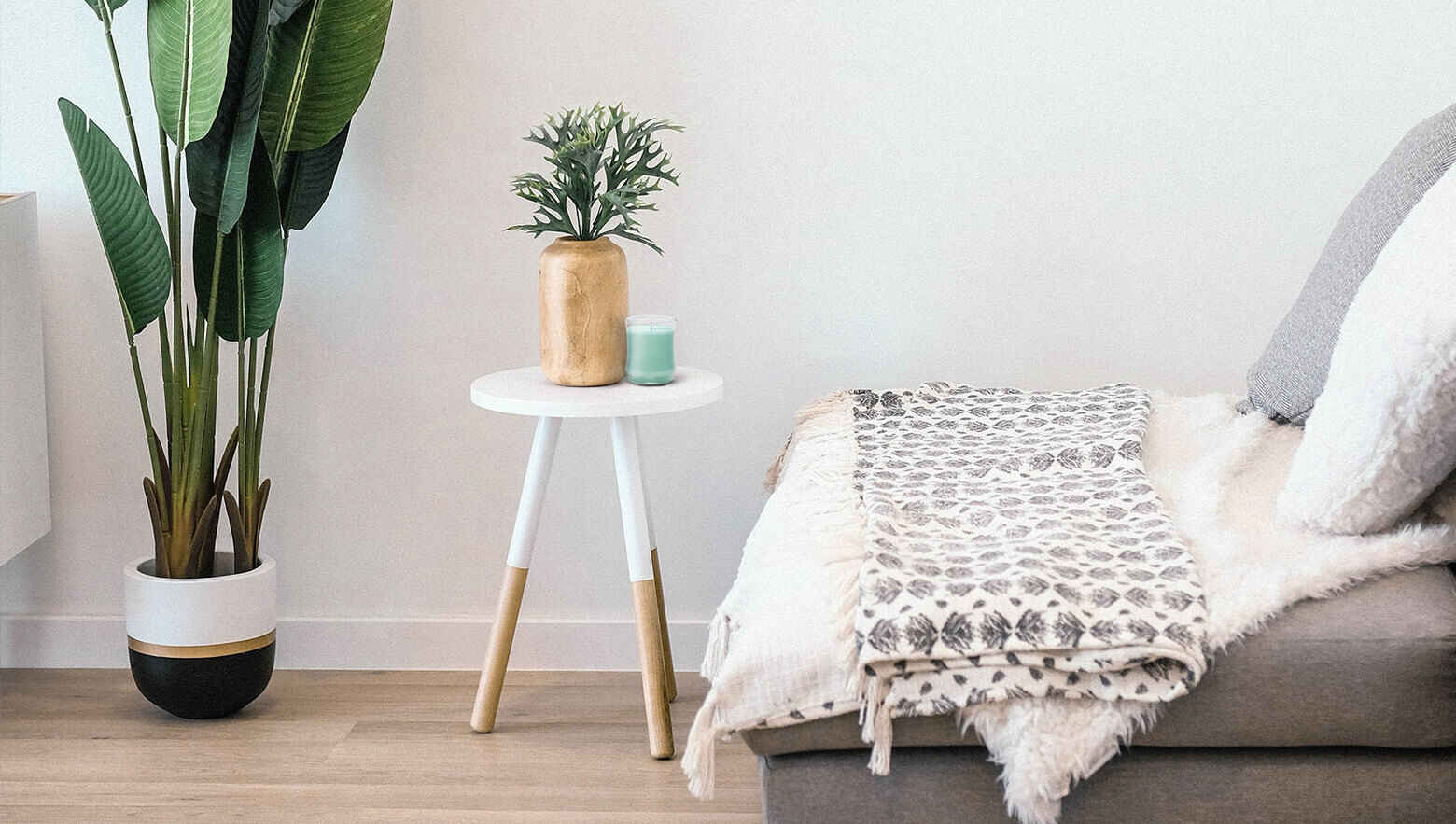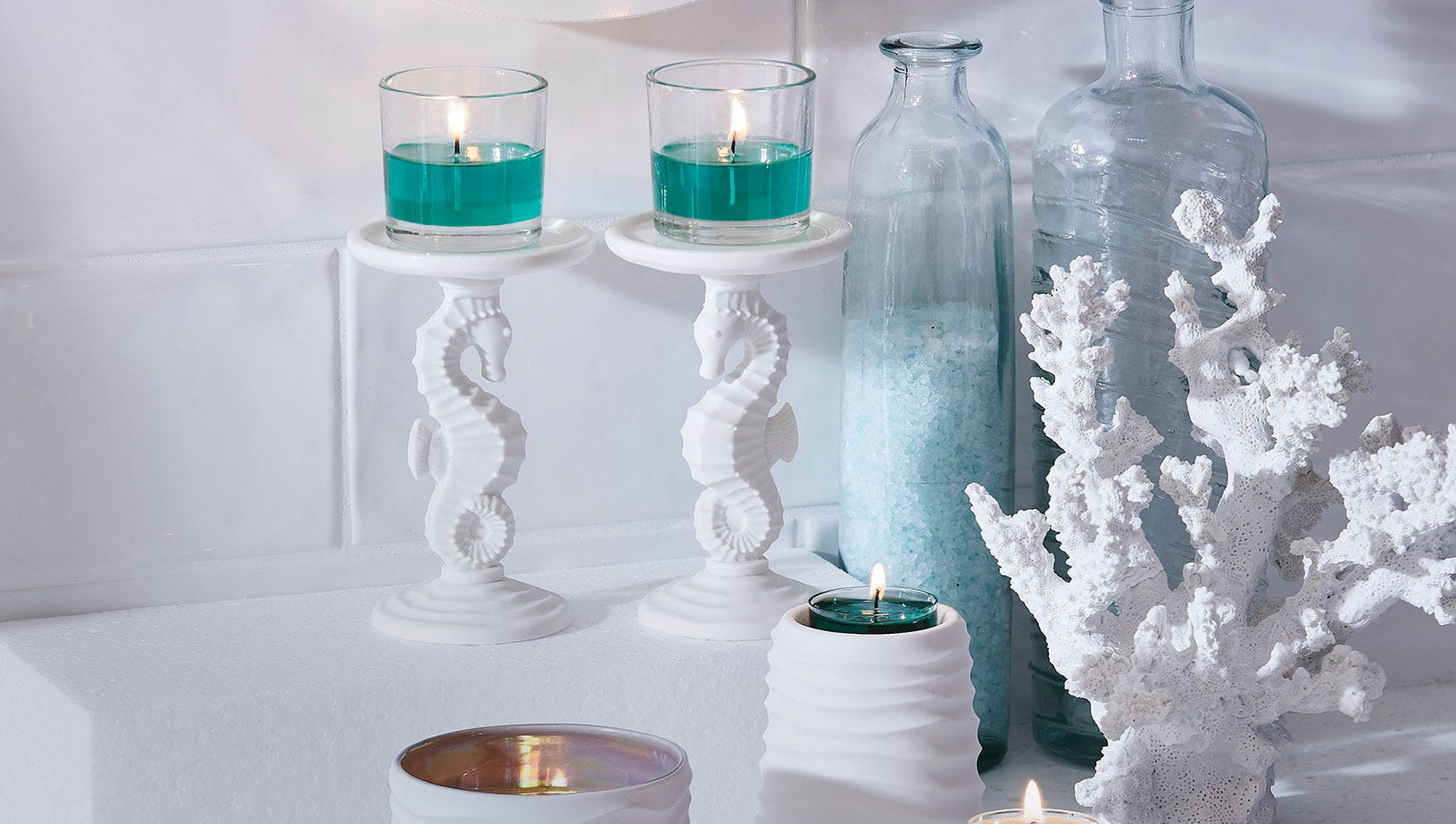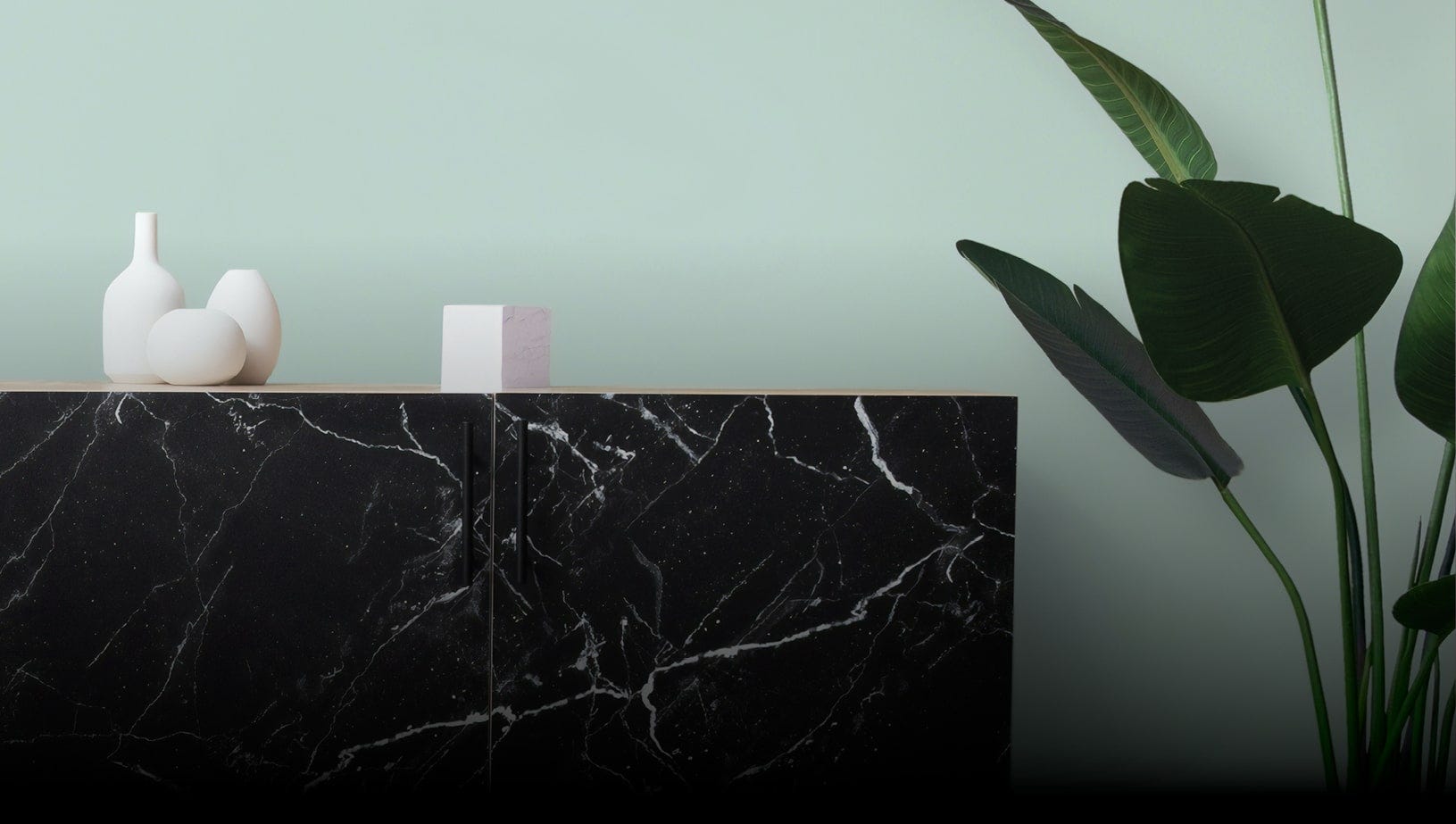Furniture is massively important in the function of your living space, but styling with accessories is the easiest way to add the finishing touches. Read on as we take you through our ultimate guide to home accessories, where we break down the different types of accessory, how to style them and how to care for them.
We explore:
- Candles and Holders
- Frames
- Clocks
- Cushions
- Plants
Candles and Holders
Different types of candles and holders
Tealight: these small and easy-to-style candles are ideal for any space, and provide 4-6 hours of gentle light. Encased in clear plastic cups so you can see the level of the wax as it burns down, and truly appreciate the beauty of the flame. Made for use with tealight holders.
Votive: love the beauty of a tealight, but want it to last longer? Votive candles offer up to 11 hours of light and liquefy completely when lit. Formulated in a unique bell-top design to ensure an even burn every time, and a more powerful fragrance throw. Votives are great to use on their own, or as part of a larger centrepiece. Use with a votive holder.
Jar: for long-lasting light in a beautiful glass jar, jar candles are the one for you. Available in a range of forms, jar candles are great standalone pieces for brightening up any space. All of our jar candles are 100% recyclable too.
3-Wick: why have one wick when you can have three? Our 3-Wick Jar Candles are a great source of light and provide up to 45 hours of fragrance. Topped with an embossed metal lid, these larger candles are a style statement on their own, or can be dressed up with a holder.
GloLite by PartyLite™: if you’re looking for an intensely bright light, our GloLites are the candle for you. The World’s Brightest Candle™ is specially formulated with our patented glow technology, meaning that it glows from top to bottom when lit.
Taper: the perfect dinner table candle, taper candles are long, sleek and elegant when used with a holder. Their simple design means that you can style them in a number of ways.
Pillar: get that classic candle look with Pillar candles. The simple design of these candles mean they can fit with any home décor style. Mix and match different sizes for a beautiful display. To use, pair with a pillar candle holder.
LED: the flameless alternative to regular candles, LED candles offer a realistic candlelight flicker that you can control at the touch of a button. A low maintenance option for busy homes. Create a show-stopping display when used with our Colour Stop Candle Bases.
How to pick the right candle
Find the perfect form to illuminate your home with our easy pointers:
- Consider the size of the space you want to illuminate. For larger rooms, you’ll need multiple candles or candles with more than one wick to create a brighter and stronger glow.
- How do you want your candles arranged? What type of display are you looking for? An eye-catching centrepiece can set the room and become a focal point for guests, but a pair of flickering tealights or votive candles can bring a cosy touch in spaces for relaxing.
- Take in your surroundings. Do you have mischievous pets and curious little ones roaming around your home? If the answer is yes, a flameless option might be more suitable to help avoid any accidents.
How to care for your candles
- Always burn the candle for a few hours until the wax melts across the whole surface the first time you light it. This ensures an even melt
- Always trim the wick to 5mm in length before each time you light your candle. This prevents soot forming around the opening of the jar
- Always keep the melted wax pool clean of any debris like wick trimmings and match heads
- Never leave a candle unattended
- Don't blow a candle out, if possible. It's much safer to use a snuffer. Blowing out your candle can cause the wax to splash and damage your furnishings
- Never place your candles near curtains or by a draught
Frames
Different types of frames
Wooden: lightweight yet sturdy, wooden frames are a versatile classic that can fit most décor styles. Available in a range of finishes and textures, these frames are a natural and timeless fit.
Floating: photographs are sandwiched between two pieces of glass or acrylic to give the impression that the photo is “floating” off of the wall. This optical illusion offers a clean and modern finish.
“Frameless”: focusing solely on the image within, “frameless” frames have no border and instead clip your photograph into place with four discrete metal clips around the edge of the glass protective panel.
Metal: solid and sleek, metal frames come in a variety of colours to fit your home style. They add a modern and minimalist feel to any setting and are more durable than other frames.
Shadow box: perfect if you’re looking to display more than just photographs. These deep set frames are ideal for artwork, sports memorabilia, badges and pins and other 3D pieces.
Collage: show off a number of different photos all at once with collage frames. Whether you want to display a collection of images from a specific occasion, or photos that share a common colour scheme, collage frames mean that you can create a beautiful display of imagery.
Standing: great for posters and large artwork, standing frames tend to be bigger than wall frames and look great leant up against your wall.
Tabletop: these classic frames have a little stand on the back so you can prop them up on any flat surface. Available in a wide range of décor styles.
Hanging: display your media and artwork anywhere on your walls with hanging frames. Many tabletop frames have a hook that allows you to hang them, but other hanging frames feature a piece of string or a chain that adds a decorative element to them.
How to hang
When it comes to displaying your frames, here are some things to think about:
- Not all frames need to be hung at the same height. If your frames are the same size, hanging them at the same height will give an even and well-balanced look. For frames in different sizes, experiment with positioning to achieve a creative and stylish finish.
- Always leave a few inches of space between frames to avoid looking crowded.
- Try to hang frames at eye level. Don’t make your guests have to strain to admire your pretty pictures!
- You don’t have to match all of your frames together. While this can give a cohesive look, mixing and matching can be much more effective.
How to care
While you might want your photographs or artwork to be the star of the show, avoid placing them in direct sunlight. This may accelerate fading and discolouration.
Most frames can be cleaned with a dust cloth or damp cloth, and glass cleaner works wonders on glass frames.
Clocks
Different types of clocks
Wall: a classic clock for home use is the wall clock. Easy to place and suitable for any room of your home, these clocks are simple and reliable. Available in a range of colours and textures to suit your style.
Tabletop: also known as mantlepiece clocks, these are perfect for any flat surfaces and don’t have to stay in one place.
Floor: for an eye-catching piece, floor clocks are the décor statement that you’ve been looking for. Grandfather clocks are the most common type of floor clock, but there are plenty of contemporary styles out there too.
Analogue: if it’s got numbers around the outside of the face with an hour and minute hand to tell the time, it’s an analogue clock. These often have a more professional look.
Pendulum: originally a vintage-style clock, pendulum clocks feature an analogue face with a swinging pendulum hanging underneath. The pendulum swings in time with the tick-tocking of the clock.
Digital: with no clock face, digital clocks simply show the exact time of the day in a digitalised format. Great for those who struggle to tell the time or are after a modern clock style.
Flap: a retro design that’s made a comeback in recent years, flap clocks display the time in a similar format to digital clocks, however the numbers flap over to change. Available in a range of colours and styles, and perfect for those looking for something a bit different.
Cushions
Different types of cushions
Square: the standard cushion shape that you can’t go wrong with. Available in a wide range of sizes, you find a square cushion to fit any sofa. Their even shape makes them well balanced and easy to style in an unlimited number of ways.
Rectangular: these cushions are great for filling in spaces and layering over square cushions. The perfect cushion to complement your existing cushion collection.
Round: if you’re after a more unusual cushion shape, round cushions are a good place to start. With no hard edges, they can be more difficult to style as they don’t tessellate as well as square shapes, however when layered with multiple other round cushions, they instantly add a lift to any room.
Patterned and printed: you can find an infinite variety of cushion patterns and prints to suit your décor taste. From jazzy prints to novelty shapes, there’s something for everyone.
Solid colour: these make great layering pieces. We love to pair a large solid colour cushion behind a smaller patterned one for a stylish look.
Tassel: sometimes cushions will have a tassel border around the edge of the case. For adding a touch of fun to your home.
Oxford: these cushions have a flat fabric border around the edge of the pillow seam. They look fancier and have a more vintage-style.
How to style
Find out our top cushion styling tips and tricks:
- Avoid piling too many cushions onto your sofa all at once. Spread them out evenly to get a better effect and let each one have its chance to shine.
- Play around with different sizes and shapes. Try layering a smaller cushion over a larger, complementary one for a 3D effect.
- While matching cushions works for some interior styles, pairing two different colour schemes or clashing prints together can make a striking look.
- Experiment with your cushion arrangement. Maybe try clustering them on either side of your sofa, or perhaps they look better in a central formation.
How to care for your cushions
Cushion covers that are made from 100% cotton can normally be machine washed, however, if your cushion is made from a more delicate fabric, you will probably need to spot clean or dry clean it.
House Plants
Different types of indoor plants
We’d be here for days if we listed all of the house plants that you can choose from, so instead, we’ve opted for some of the most common indoor plants available:
Cactus: spiky, forgiving and also a member of the succulent family. These plants are low-maintenance and can be left mainly to their own accord. Discover a whole range of cacti in different shapes and sizes.
Succulent: now this is where it gets confusing. Did you know that all cacti are succulents, but not all succulents are cacti? Well, now you do! Succulents are tough going plants that can survive on only being watered every now and again.
Swiss Cheese: this South American native produces the most beautiful fan-like leaves. Swiss cheese plants grow tall, so these are a great option if you’re looking for a floor plant.
Aloe Vera: not only nice to look at, the aloe vera plant has incredible medical benefits too. From treating cuts and scrapes, aloe vera is also more commonly used in soothing sunburn. It’s pointed leaves form an interesting shape to keep in your home.
Spider: identified by its long, thin, arching stems, spider plants are a popular choice due to their easy-care nature.
English ivy: while often grown outdoors, ivy looks spectacular indoors due to its long trailing stems. Ivy however, is poisonous if consumed by pets or children.
Orchid: if you’re after a vibrant dash of colour, orchids are a gorgeous choice. They’re relatively forgiving and prefer low light.
How to pick the right plant for you
Unlike other home accessories, plants require a little care, so it’s important to find the best one for you and your lifestyle. Browse our best pointers on selecting the plant for you:
- Select something that you know you’ll be able to maintain. We’ve listed plenty of easy-care options in our plant types list for a reason! We understand that many people don’t have the time to be nurturing a plant 24/7, so choose something that will be manageable for you.
- Read up on different plants’ requirements. Some plants attract insects and mites that can cause you more hassle than they’re worth, while some plants require a specific climate in order to thrive. Do your research before you shop.
- Consider how much space you have available. Many plants stop growing after a while, but others can grow to great heights (and lengths!) when mature, so this is definitely something to consider.
- If you also share your home with pets, you’ll want to consider a pet-friendly option. Certain strains of ivy, fern, succulent and bamboo are perfect to share space with any furry companions as they’re non-toxic
How to style
Your grandmother’s garden may bring back memories of old, terracotta, outdoor planters, so you’ll be relieved to hear that there’s much more variety when it comes to indoor plant pots. Discover ceramic, stone, wood, metal, marble materials and more. You can even clean out your old glass candle jars and use them as planters too. In a huge selection of colours, prints and finishes, there’s definitely a planter to match your home style.
From hanging plant pots to a whole shelf of foliage, there are so many different options for styling your indoor plants. Add a touch of sophistication with a planter on legs or with a stand. Larger plants make great standalone floor pieces, making the individual colour and shape of the leaves contrast against your existing décor.
If you’re short on space, wall plants are a great option as they can be hung from any area to instantly brighten up your room. Wall planters are available in many different styles and are easily set up. We like to install these with succulents and ferns as they require little care.
While lining your plants along a shelf can be an easy option, try to arrange your plants at different heights to achieve a more interesting visual. Plants with long leaves look great draped down a bookcase, whereas plants with tall sprouting stems can help to add depth along a windowsill or mantlepiece.
For more interior inspiration and home styling guides, visit our blog to discover more ways to make your house feel like a home.













